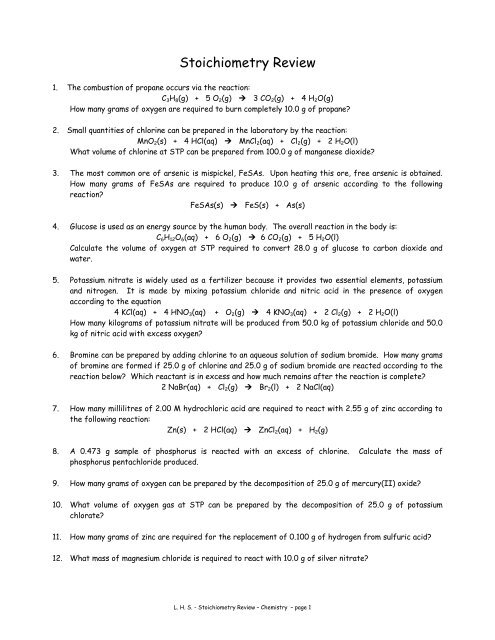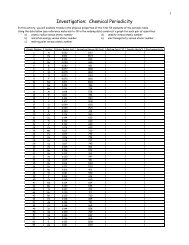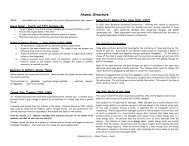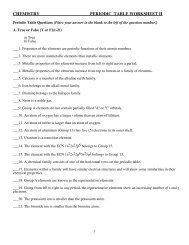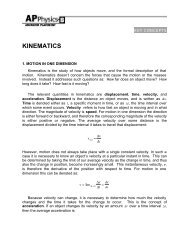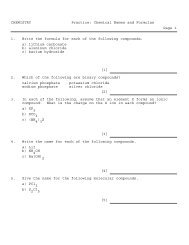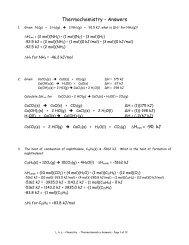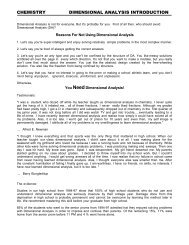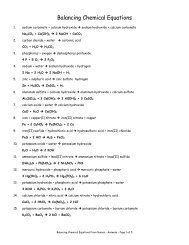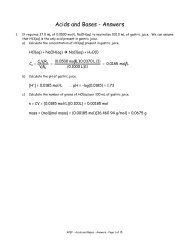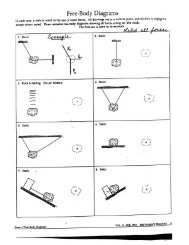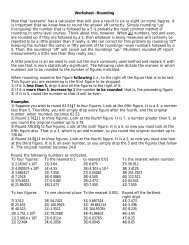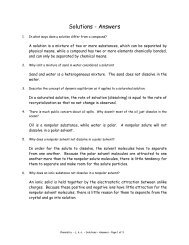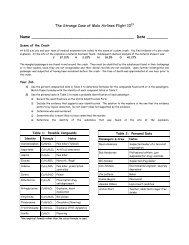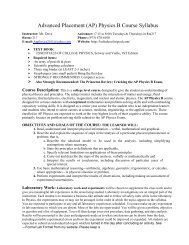Stoichiometry Review
Stoichiometry Review
Stoichiometry Review
Create successful ePaper yourself
Turn your PDF publications into a flip-book with our unique Google optimized e-Paper software.
<strong>Stoichiometry</strong> <strong>Review</strong><br />
1. The combustion of propane occurs via the reaction:<br />
C 3 H 8 (g) + 5 O 2 (g) 3 CO 2 (g) + 4 H 2 O(g)<br />
How many grams of oxygen are required to burn completely 10.0 g of propane?<br />
2. Small quantities of chlorine can be prepared in the laboratory by the reaction:<br />
MnO 2 (s) + 4 HCl(aq) MnCl 2 (aq) + Cl 2 (g) + 2 H 2 O(l)<br />
What volume of chlorine at STP can be prepared from 100.0 g of manganese dioxide?<br />
3. The most common ore of arsenic is mispickel, FeSAs. Upon heating this ore, free arsenic is obtained.<br />
How many grams of FeSAs are required to produce 10.0 g of arsenic according to the following<br />
reaction?<br />
FeSAs(s) FeS(s) + As(s)<br />
4. Glucose is used as an energy source by the human body. The overall reaction in the body is:<br />
C 6 H 12 O 6 (aq) + 6 O 2 (g) 6 CO 2 (g) + 5 H 2 O(l)<br />
Calculate the volume of oxygen at STP required to convert 28.0 g of glucose to carbon dioxide and<br />
water.<br />
5. Potassium nitrate is widely used as a fertilizer because it provides two essential elements, potassium<br />
and nitrogen. It is made by mixing potassium chloride and nitric acid in the presence of oxygen<br />
according to the equation<br />
4 KCl(aq) + 4 HNO 3 (aq) + O 2 (g) 4 KNO 3 (aq) + 2 Cl 2 (g) + 2 H 2 O(l)<br />
How many kilograms of potassium nitrate will be produced from 50.0 kg of potassium chloride and 50.0<br />
kg of nitric acid with excess oxygen?<br />
6. Bromine can be prepared by adding chlorine to an aqueous solution of sodium bromide. How many grams<br />
of bromine are formed if 25.0 g of chlorine and 25.0 g of sodium bromide are reacted according to the<br />
reaction below? Which reactant is in excess and how much remains after the reaction is complete?<br />
2 NaBr(aq) + Cl 2 (g) Br 2 (l) + 2 NaCl(aq)<br />
7. How many millilitres of 2.00 M hydrochloric acid are required to react with 2.55 g of zinc according to<br />
the following reaction:<br />
Zn(s) + 2 HCl(aq) ZnCl 2 (aq) + H 2 (g)<br />
8. A 0.473 g sample of phosphorus is reacted with an excess of chlorine. Calculate the mass of<br />
phosphorus pentachloride produced.<br />
9. How many grams of oxygen can be prepared by the decomposition of 25.0 g of mercury(II) oxide?<br />
10. What volume of oxygen gas at STP can be prepared by the decomposition of 25.0 g of potassium<br />
chlorate?<br />
11. How many grams of zinc are required for the replacement of 0.100 g of hydrogen from sulfuric acid?<br />
12. What mass of magnesium chloride is required to react with 10.0 g of silver nitrate?<br />
L. H. S. - <strong>Stoichiometry</strong> <strong>Review</strong> – Chemistry – page 1
13. Determine the volume of hydrogen gas at STP that can be produced by the reaction of 130.0 g of zinc<br />
with 100.0 g of hydrochloric acid. Which reactant is in excess, and how much remains unreacted?<br />
14. 29.6 mL of 0.350 M sodium hydroxide are required to titrate 20.0 mL of phosphoric acid. Calculate the<br />
molarity of the phosphoric acid.<br />
15. What mass of copper(II) hydroxide is precipitated by the reaction of 2.67 g of potassium hydroxide<br />
with copper(II) nitrate?<br />
16. Ammonium sulfate fertilizer is manufactured by having sulfuric acid react with ammonia. In a<br />
laboratory study of this process, 50.0 mL of sulfuric acid reacts with 24.4 mL of a 2.20 mol/L<br />
ammonium hydroxide solution. From this evidence, calculate the concentration of the sulfuric acid at<br />
this stage in the process.<br />
17. Slaked lime can be added to an aluminum sulfate solution in a water treatment plant to clarify the<br />
water. Fine particles in the water stick to the precipitate produced. Calculate the volume of 0.0250<br />
mol/L calcium hydroxide solution required to react completely with 25.0 mL of 0.125 mol/L aluminum<br />
sulfate solution.<br />
18. Some antacid products contain aluminum hydroxide to neutralize excess stomach acid. Determine the<br />
volume of 0.100 mol/L stomach acid (assumed to be HCl) that can be neutralized by 912 mg of aluminum<br />
hydroxide in an antacid tablet.<br />
19. Iron(II) sulfide reacts with oxygen gas to produce iron(III) oxide and sulfur dioxide. What mass of<br />
iron(III) oxide is produced from the reaction of 20.0 g of iron(II) sulfide and 14.1 g of oxygen? Which<br />
reactant is in excess, and how much remains unreacted?<br />
20. The chemical equation below describes what happens when a match is struck against a rough surface to<br />
produce light and heat.<br />
P 4 S 3 (s) + O 2 (g) P 4 O 10 (g) + SO 2 (g)<br />
a) Balance this chemical equation<br />
b) If 5.3 L of oxygen gas at STP were consumed, what volume of sulfur dioxide at STP would be<br />
produced?<br />
c) What mass of P 4 S 3 would be consumed in the same reaction described in (b)?<br />
21. Titanium(IV) chloride reacts violently with water vapour to produce titanium(IV) oxide and hydrogen<br />
chloride gas. Titanium(IV) oxide, when finely powdered, is extensively used in paint as a white pigment.<br />
TiCl 4 (s) + H 2 O(l) TiO 2 (s) + 4HCl(g)<br />
The reaction has been used to create smoke screens. In moist air, the titanium(IV) chloride reacts to<br />
produce a thick smoke of suspended titanium(IV) oxide particles. What mass of titanium(IV) oxide can<br />
be expected when 85.6 g of titanium(IV) chloride is reacted with excess water vapour?<br />
22. 1.56 g of As 2 S 3 , 0.140 g of H 2 O, 1.23 g of HNO 3 , and 3.50 g of NaNO 3 are reacted according to the<br />
equation below:<br />
3As 2 S 3 (s) + 4H 2 O(l) + 10HNO 3 (aq) + 18NaNO 3 (aq) 9Na 2 SO 4 (aq) + 6H 3 AsO 4 (aq) + 28NO(g)<br />
a) What mass of H 3 AsO 4 is produced?<br />
b) What volume (at STP) of NO is produced?<br />
L. H. S. - <strong>Stoichiometry</strong> <strong>Review</strong> – Chemistry – page 2


